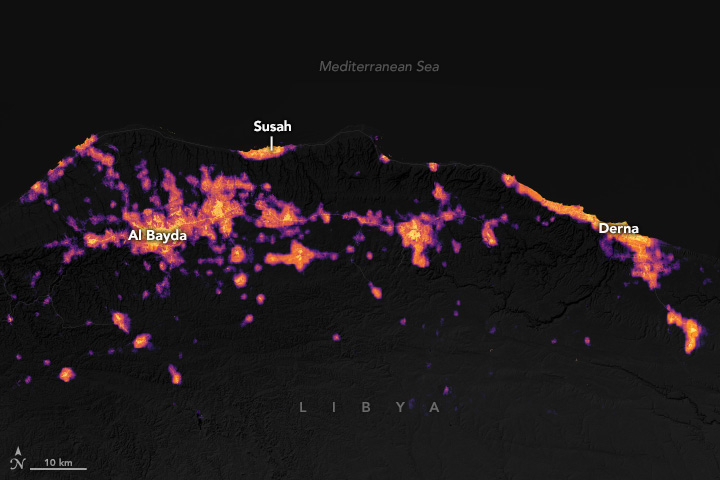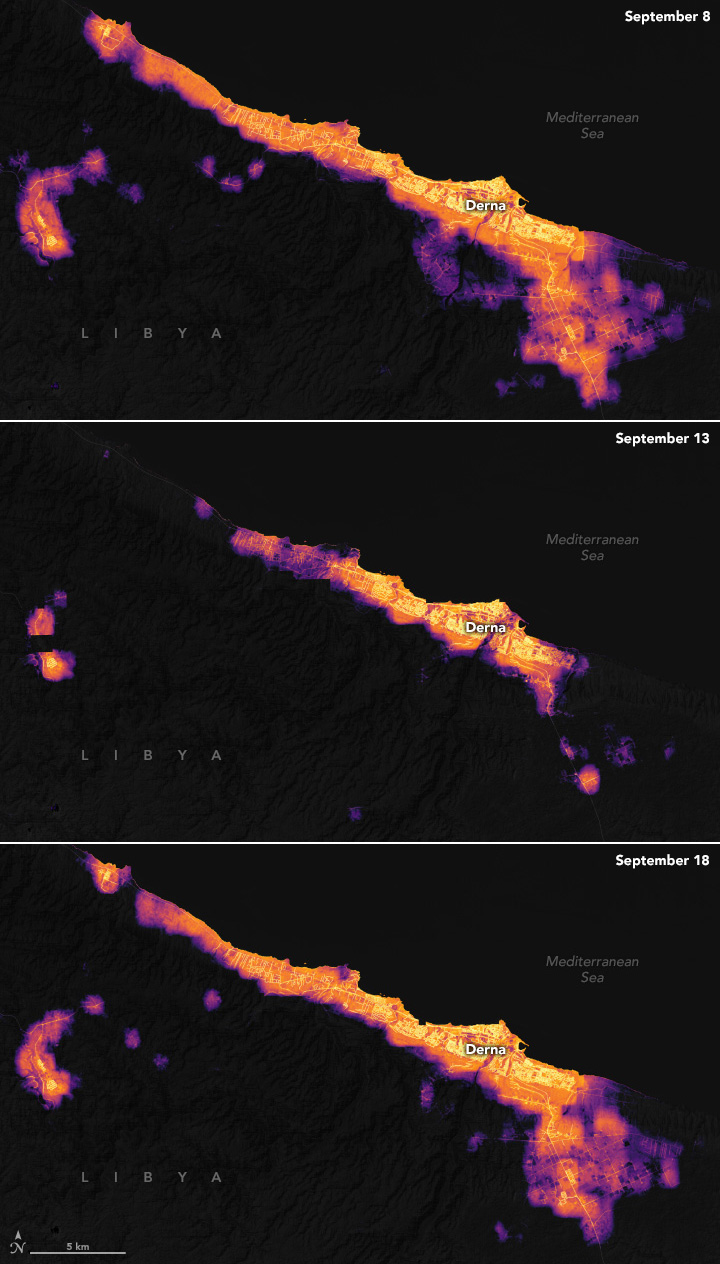
Tracking Nightlights in Libya
Downloads
- libya_bmhd_2023251_lrg.jpg (8037x5358, JPEG)
- libya_bmhd_2023256_lrg.jpg (8037x5358, JPEG)
- libyacomp_bmhd_2023261.jpg (720x1264, JPEG)
Metadata
- Sensor(s):
- Suomi NPP - VIIRS
- Landsat 8 - OLI
- Landsat 9 - OLI-2
- Data Date: September 8, 2023 - September 13, 2023
- Visualization Date: September 21, 2023
On September 10, 2023, a potent storm brought heavy rain to northeastern Libya, causing significant loss of life and devastation to cities along the coast. Data from satellites show that after the storm, many communities in the region had lost electric power.
The storm—a Mediterranean hurricane-like system known as a medicane—brought 414 millimeters (16 inches) of rain to the city of Al Bayda. Nearby, the port city of Derna received more than 100 millimeters (4 inches)—far exceeding the city’s average monthly rainfall for September of less than 1.5 millimeters (0.1 inches).
Flash floods swept away roads and entire neighborhoods, displacing around 40,000 people across the country. Preliminary estimates by the United Nations Satellite Center (UNOSAT) indicate that about 10,000 buildings were damaged by floodwater, although assessment of the damage was still ongoing as of September 22. Infrastructure damage led to power outages, which can be seen in satellite images acquired at night.
The maps above show the amount of light emitted from affected communities in northeastern Libya before and after the storm and the peak of the torrential flooding. The left map shows the area on September 8, 2023; the right map shows the same area on September 13, three days after the storm made landfall.
“There was a substantial loss of power evident in the vicinity of Derna and Al Bayda in the September 13 image when compared to the baseline image,” said Ranjay Shrestha of NASA’s Black Marble science team. The maps come from the Black Marble HD product, provided by Shrestha and Zhuosen Wang, a principal investigator on the science team, and are based on data from the Visible Infrared Imaging Radiometer Suite (VIIRS) sensor on the NASA-NOAA Suomi NPP satellite. The basemap was built from data collected by Landsat 8 and Landsat 9 satellites.
Derna was devastated by the storm. Flooding in the city led to the collapse of two dams along a usually dry riverbed, or wadi. The dam failures unleashed 3- to 7-meter-high floodwater that tore through the city, sweeping roads and buildings out to sea.
The city became significantly darker after the storm hit. In a recent report, UNOSAT documented changes in Derna’s brightness. UNOSAT uses Black Marble nighttime light products to support ground teams for disaster response.

Some communities near Derna went four days without electricity, according to NPR reporting. But by September 18, 2023, the brightness of outdoor lighting in Derna was approaching pre-storm levels. “There’s a lot more recovery compared to the September 13 image,” said Shrestha. “However, there are still pockets of areas, particularly in the outskirts of the Al Bayda area, where recovery seems ongoing.”
Raw, unprocessed images of night lights can be misleading because moonlight, clouds, air pollution, snow cover, seasonal vegetation, and even the position of the satellite, can change how light is reflected. The Black Marble science team processes the data to account for these factors.
References & Resources
- NASA (2023) The Black Marble Project. Accessed September 22, 2023.
- NASA Earth Observatory (2023, September 21) Storm Aftermath in Derna, Libya. Accessed September 22, 2023.
- NASA Earth Observatory (2023, September 14) Torrential Rain Wreaks Havoc in Libya. Accessed September 22, 2023.
- NPR (2023, September 15) Survivors of Libya’s deadly floods describe catastrophic scenes and tragic losses. Accessed September 22, 2023.
- UN International Organization for Migration (IOM), via ReliefWeb (2023, September 17) Libya - Storm Daniel Flash Update 4, Displacement Tracking Matrix. Accessed September 22, 2023.
- UN Satellite Center (UNOSAT) Webmap: Flood impact assessment in Derna City, East Province, Libya. Accessed September 22, 2023.
- UN Satellite Center (UNOSAT) (2023, September 20) Night-Time Light Loss Assessment in Derna & Al Bayda (Libya) using Night-time Light Imagery. Accessed September 22, 2023.
NASA Earth Observatory images by Wanmei Liang, using Black Marble data courtesy of Ranjay Shrestha and Zhuosen Wang/NASA Goddard Space Flight Center, Landsat data from the U.S. Geological Survey, and data from OpenStreetMap. Story by Emily Cassidy.
This image record originally appeared on the Earth Observatory. Click here to view the full, original record.